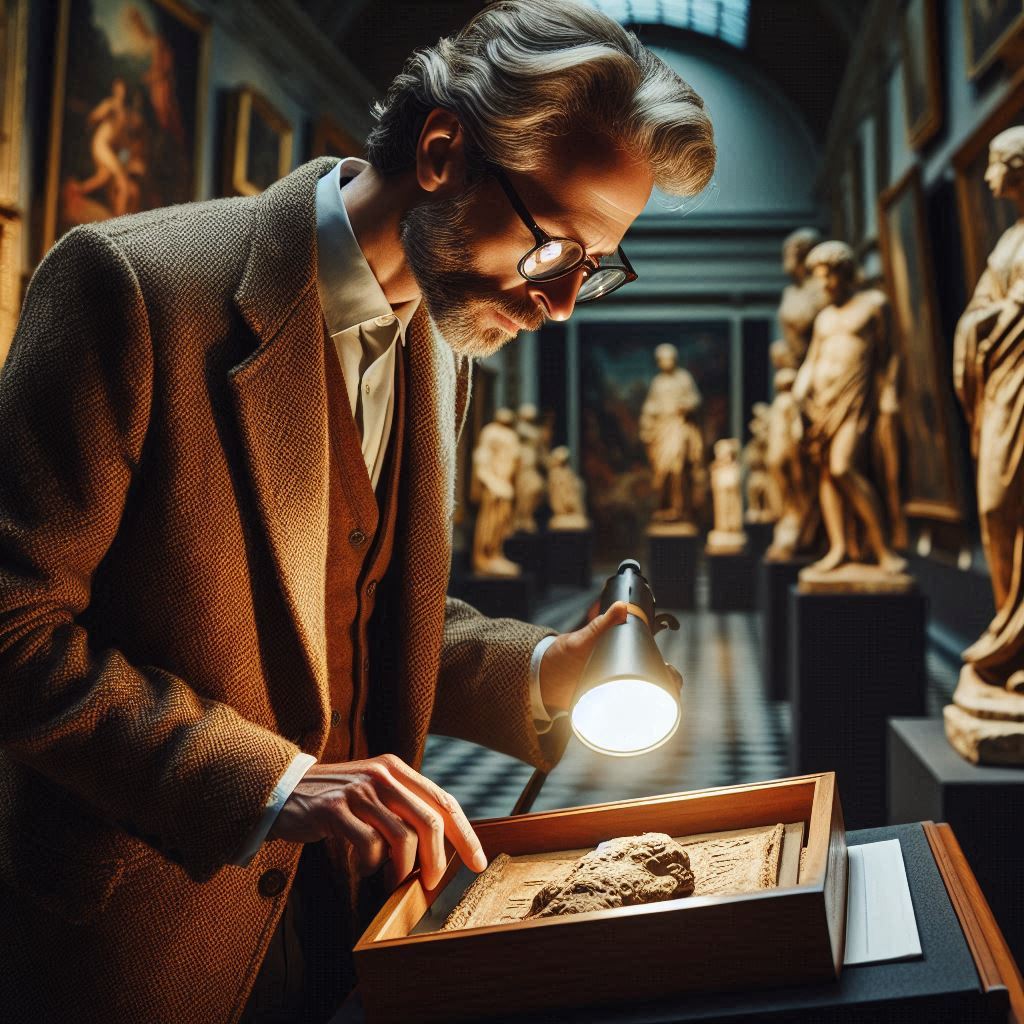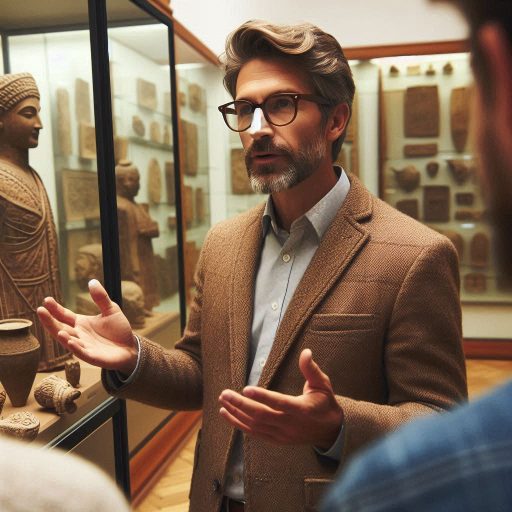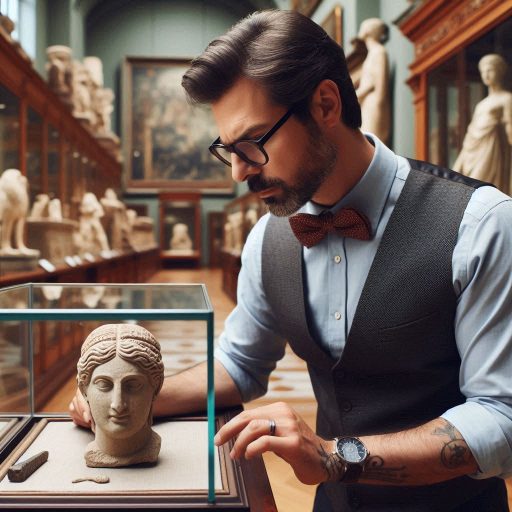Introduction
Museum curators play a crucial role in preserving culture and history.
Reading books helps curators stay informed, inspired, and sharp.
A well-rounded library can elevate their expertise and enrich the visitor experience.
Whether curating art, artifacts, or history, knowledge is key.
The right books offer insight into exhibit planning, collection management, and audience engagement.
For aspiring or current curators, continual learning is essential.
In this blog post, we’ll explore five must-read books that every curator should have on their shelf.
These books cover topics like curatorial theory, museum management, and innovative exhibition design.
Whether you’re a seasoned professional or new to the field, these books offer valuable guidance.
From understanding the ethics of curation to mastering the logistics of large-scale exhibitions, each book offers unique insights.
Reading these will sharpen your skills and broaden your perspective.
Now, let’s dive into the top five books that every museum curator should read to succeed in the dynamic world of museum curation.
Book 1: The Participatory Museum by Nina Simon
The Participatory Museum by Nina Simon is a must-read for museum curators.
The book introduces a fresh approach to museum engagement, where audiences are encouraged to participate actively.
Simon promotes the idea of transforming passive museum visitors into co-creators of experiences.
This is achieved through interactive exhibits and collaborative storytelling, where visitors become part of the narrative.
Summary of the Book, Key Concepts and Themes
One of the central ideas is that museums should be spaces for dialogue, not just education.
Simon explores how museums can become social hubs, where visitors engage with content and with one another.
She emphasizes the importance of creating a visitor-centered experience, where audience feedback shapes future exhibits.
This participatory approach encourages museums to be more flexible and responsive to their communities.
Another major theme is collaboration.
Simon believes museums should work closely with their visitors to co-create exhibits.
Instead of simply displaying objects, museums can create experiences that reflect the interests and ideas of their audience.
This not only enhances visitor engagement but also fosters a sense of ownership among the community.
How This Book Can Help Museum Curators Engage Audiences
For museum curators, The Participatory Museum offers practical strategies for engaging modern audiences.
It highlights ways to make exhibitions more interactive and relevant to visitors‘ lives.
By applying Simon’s principles, curators can create spaces that invite people to contribute, rather than simply observe.
This approach makes museums more dynamic, relevant, and inclusive.
Simon‘s ideas also encourage curators to rethink their role.
Instead of being gatekeepers of knowledge, curators become facilitators of experiences.
By creating opportunities for visitor input, they empower audiences to shape the museum’s direction.
This results in deeper engagement, repeat visits, and a more loyal audience.
Insights from Museum Professionals
Museum professionals who have read The Participatory Museum often praise its innovative approach.
Sarah Johnson, a curator at a regional museum, notes, “Nina Simon‘s ideas completely transformed how I think about museum spaces.
We now involve visitors in exhibit planning and get more feedback than ever.
” Another curator, James O‘Neill, states, “Simon‘s book gave me concrete tools to make our exhibits more interactive.”
Visitors love contributing their own stories.
Many professionals also find the book‘s ideas adaptable.
One museum educator said, “Even in smaller museums with limited budgets, these concepts work.”
We‘ve found low-cost ways to involve visitors in creating exhibits.
The Participatory Museum remains a vital resource for curators looking to engage audiences more meaningfully.
Simon’s book is a guide to reimagining museum spaces, transforming visitors from passive observers into active participants.
Read: How to Create Memorable Characters: Pro Tips
Book 2: Exhibiting Cultures: The Poetics and Politics of Museum Display by Ivan Karp and Steven D. Lavine
Overview of Cultural Representation in Museums
Exhibiting Cultures delves into the complexities of how museums represent cultures.
Ivan Karp and Steven D. Lavine offer a thought-provoking analysis of the politics behind museum exhibits.
This book addresses the challenges museums face in representing different cultures authentically.
Through a series of essays, the authors explore how cultural displays shape public understanding of identity, history, and art.
Museums are cultural gatekeepers, shaping how we see the world.
Exhibiting Cultures challenges curators to rethink their roles.
The book emphasizes the importance of presenting cultures without reinforcing stereotypes.
The essays offer case studies from various museum contexts, highlighting both successes and failures in cultural representation.
Karp and Lavine question the traditional practices of exhibiting non-Western cultures.
They argue that curators must balance aesthetic presentation with social responsibility.
This book promotes a dialogue between curators and communities, advocating for more inclusive, authentic exhibitions.
Enhancing Curatorial Practices and Exhibit Design
This book is a vital resource for curators looking to improve their exhibit design.
It encourages curators to consider the impact of their displays on diverse audiences.
The book urges curators to move beyond conventional displays that reinforce dominant cultural narratives.
Instead, it suggests creating spaces that invite critical thinking and dialogue.
By reading Exhibiting Cultures, curators can learn to incorporate multiple perspectives in their exhibits.
The essays provide strategies for presenting objects in ways that respect their cultural origins.
The book teaches curators to be mindful of how exhibits can perpetuate colonial narratives or marginalize certain groups.
For curators, this book offers practical insights into the ethics of display.
It encourages curators to collaborate with the communities represented in their exhibitions.
This practice can result in more dynamic and meaningful exhibits that resonate with broader audiences.
Comparison with Other Museum Studies Literature
Compared to other museum studies literature, Exhibiting Cultures stands out for its critical approach to representation.
While many books on curatorial practice focus on logistics or art history, this book challenges the very foundations of museum work.
It asks readers to reconsider how and why certain cultures are displayed the way they are.
In contrast to traditional museum studies texts, Exhibiting Cultures offers a deeper examination of the political and social implications of museum exhibits.
Other books may focus on the technical aspects of curation, but Karp and Lavine explore the philosophical and ethical dilemmas of the profession.
This book makes a unique contribution by combining theory with real-world examples.
It connects abstract ideas about culture with practical strategies for exhibit design.
For curators, this blend of theory and practice makes Exhibiting Cultures an invaluable resource for developing more thoughtful, inclusive exhibitions.
Read: Ceramic Art Exhibitions to Visit in 2024
Book 3: The Manual of Museum Exhibitions edited by Barry Lord and Gail Dexter Lord
When it comes to creating compelling museum exhibitions, having a guide like The Manual of Museum Exhibitions can be invaluable.
This book, edited by Barry Lord and Gail Dexter Lord, provides practical advice, guidelines, and insights that can help museum curators elevate their exhibits to new heights.
Description of the practical advice and guidelines provided in the book
The Manual of Museum Exhibitions covers a wide range of topics essential for curators and museum professionals.
From the initial concept development to the final installation, this book offers step-by-step guidance on every aspect of creating engaging exhibitions.
The book delves into the importance of storytelling in exhibitions, emphasizing the power of narrative to captivate audiences and convey complex ideas.
It also provides in-depth information on design principles, layout strategies, and interactive components that can enhance visitor experiences.
One of the key strengths of this manual is its focus on audience engagement.
By understanding the needs and preferences of museum visitors, curators can tailor their exhibitions to create meaningful connections and lasting impressions.
Examples of successful museum exhibitions inspired by this manual
Many museums around the world have drawn inspiration from The Manual of Museum Exhibitions to create impactful displays that resonate with diverse audiences.
One notable example is the Smithsonian National Museum of Natural History’s exhibition on biodiversity.
Utilizing the principles outlined in the book, the museum curated an interactive experience that showcased the interconnectedness of various ecosystems and highlighted the importance of conservation efforts.
Through engaging displays and hands-on activities, visitors were able to explore the fragility and beauty of our planet’s biodiversity.
Another successful exhibition inspired by this manual is the British Museum’s “Egyptian Treasures” showcase.
The museum uses storytelling and immersive displays to bring ancient Egyptian artifacts to life.
Visitors are transported back in time, exploring the richness of this ancient civilization.
Testimonials from museum professionals who have found the book valuable in their work
Many museum professionals have lauded The Manual of Museum Exhibitions for its practical insights and actionable recommendations.
Curators, exhibition designers, and museum directors have all found immense value in the guidance provided by this comprehensive manual.
Dr. Emily Chang, a curator at the Louvre Museum, praised the book for its thorough approach to exhibition development.
She noted that the strategies outlined in the manual helped her team create a blockbuster exhibition that drew record attendance and critical acclaim.
John Reynolds, a museum director in New York, shared how The Manual of Museum Exhibitions revolutionized his approach to exhibition planning.
By implementing the book’s principles, his museum was able to engage new audiences and foster a deeper appreciation for art and culture.
Read: Character Design Trends: What‘s Hot in 2024?

Find Out More: Funding and Grants for Museum Curatorial Projects
Transform Your Career Today
Unlock a personalized career strategy that drives real results. Get tailored advice and a roadmap designed just for you.
Start NowBook 4: Curating at the Edge: Artists Respond to the U.S./Mexico Border by Kate Bonansinga
Kate Bonansinga‘s Curating at the Edge is a vital read for museum curators.
The book examines how curators navigate the sensitive topic of the U.S./Mexico border.
Bonansinga uses real-world examples to illustrate the challenges curators face when dealing with politically charged subjects.
How Curators Address Social and Political Issues
Bonansinga’s book highlights the crucial role curators play in bringing attention to social and political issues.
She provides case studies showing how artists from the U.S./Mexico border region respond to the complex realities of border life.
Curators must balance presenting art that addresses these themes while respecting the sensitive nature of the topic.
The book emphasizes that curators are not just passive presenters of art but active participants in shaping public discourse.
Case Studies from the U.S./Mexico Border Region
Curating at the Edge includes powerful case studies that showcase how art reflects the U.S./Mexico border region‘s cultural and political landscape.
The book provides detailed examples of exhibitions that explore themes such as immigration, identity, and human rights.
Bonansinga illustrates how curators collaborate with artists to tell these stories in a way that resonates with both local and international audiences.
She shows how curators can give voice to marginalized communities while fostering meaningful dialogue.
Ethical Considerations for Museum Curators and Challenges of Curating Sensitive Topics
One of the most compelling aspects of Bonansinga‘s book is her exploration of the ethical challenges curators face when addressing controversial issues.
She reflects on the responsibility curators hold in ensuring that exhibitions remain respectful and inclusive.
Curating politically sensitive topics like the U.S./Mexico border requires a careful balance between activism and objectivity.
Bonansinga stresses the importance of considering how the audience will interpret the work and how it might impact the communities involved.
Bonansinga also delves into the unique challenges of curating art that deals with sensitive social and political issues.
She discusses the difficulties in choosing works that reflect the complexities of border life without simplifying or sensationalizing them.
Curators must grapple with questions about representation, authenticity, and audience reception.
The book offers insights into how curators can navigate these challenges while maintaining the integrity of the exhibitions.
Curating at the Edge is more than just a book about the U.S./Mexico border.
It is a thoughtful guide for curators who want to engage with social and political issues in a meaningful way.
Bonansinga‘s work serves as a reminder that curators have the power to influence public opinion and provoke important conversations.
By examining case studies, reflecting on ethical considerations, and acknowledging the challenges, the book equips curators with the tools to thoughtfully curate sensitive topics.
Read: How to Price Your Ceramic Artwork
Book 5: The Art Museum in Modern Times by Charles Saumarez Smith
Overview of the Historical Context and Evolution of Art Museums
Charles Saumarez Smith’s The Art Museum in Modern Times offers a comprehensive exploration of art museums’ evolution.
This book traces the historical development of these institutions from their inception to contemporary practices.
Saumarez Smith discusses how art museums originated as private collections.
Wealthy individuals often showcased their treasures to impress others.
Over time, these collections transformed into public institutions, opening their doors to all.
The book highlights key milestones in the history of art museums.
Saumarez Smith delves into the founding of prominent museums, such as the British Museum and the Louvre.
He emphasizes how these institutions reflect the cultural values and aspirations of their time.
Saumarez Smith also examines the impact of social and political changes on art museums.
He connects the rise of nationalism and globalization to the evolving roles of these institutions.
Analysis of the Changing Roles and Responsibilities of Museum Curators in Modern Times
Saumarez Smith’s analysis extends to the changing roles of museum curators.
He argues that curators have evolved from mere custodians of art to active interpreters of culture.
In modern times, curators face new challenges and responsibilities.
They now engage with diverse audiences and facilitate broader conversations about art.
The book discusses how technology influences curatorial practices.
Curators use digital tools to enhance visitor experiences and broaden access to art.
Saumarez Smith highlights the importance of inclusivity and representation in exhibitions.
He asserts that curators must consider diverse perspectives when presenting artworks.
This shift in responsibility allows for a more comprehensive understanding of art’s societal impact.
Furthermore, Saumarez Smith explores how curators navigate ethical considerations.
They often confront issues such as cultural appropriation and provenance.
This responsibility requires curators to engage in ongoing dialogue with communities.
By doing so, they can create more meaningful and relevant exhibitions.
Consideration of How This Book Can Inform Curatorial Practices in the Future
The Art Museum in Modern Times serves as an essential resource for current and aspiring curators.
Saumarez Smith‘s insights can inform curatorial practices for years to come.
His emphasis on the historical context of art museums encourages curators to reflect on their institutions’ legacies.
This reflection can lead to more thoughtful and responsible curatorial decisions.
Moreover, the book highlights the importance of adaptability in curatorial roles.
Curators must remain responsive to cultural shifts and technological advancements.
Saumarez Smith‘s analysis inspires curators to embrace innovation while honoring tradition.
His call for inclusivity and representation can lead to more enriching visitor experiences.
Saumarez Smith’s work provides valuable guidance for future curators.
By understanding the historical context and evolving responsibilities, they can foster engaging and meaningful connections with audiences.
This book will undoubtedly inspire curators to rethink their practices and embrace the challenges of modernity.
Conclusion
In this post, we explored five essential books for museum curators.
These books offer invaluable insights into curatorial practice, museum management, and exhibition design.
Each one equips readers with the tools needed to excel in the field.
By reading Curatorial Activism, you‘ll understand the importance of inclusivity in exhibitions.
Exhibit Labels: An Interpretive Approach teaches the art of engaging storytelling through exhibit text.
The Museum Curator’s Companion provides practical advice on collection care and development.
Thinking about Exhibitions challenges you to think creatively about exhibition spaces.
Finally, Museums and Communities highlights the role of museums in building meaningful connections with the public.
These books are vital resources for expanding your knowledge and improving your curatorial skills.
I encourage museum professionals to dive into these works to enhance their expertise.
What‘s your favorite museum curator book? Share your recommendations or thoughts in the comments! Your insights might inspire fellow readers to expand their own reading lists.
Let‘s keep the conversation going and continue growing as a community of museum professionals.




